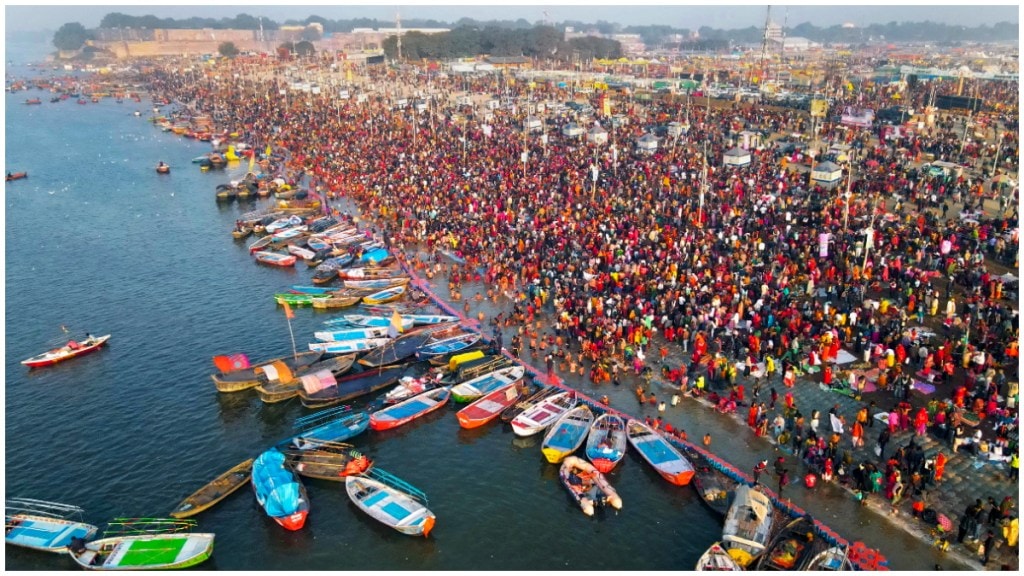Imagine the brands you casually browse in grocery store aisles stepping out to rescue, guide, and comfort you amidst the chaotic sea of devotees at the grand Maha Kumbh. With an estimated 400 million pilgrims attending, brands have transformed this religious gathering into an expansive marketing laboratory. But this year, it’s more than just visibility—it’s about blending purpose with promotion, ensuring a tangible presence beyond billboards.
Experiential marketing takes centre stage
Brands are leveraging Maha Kumbh as a platform to go beyond traditional advertising. “Experiential marketing at the Maha Kumbh has proven to be a highly effective strategy for brands aiming to enhance engagement and brand recall,” said Vikas Nowal, CEO at Interspace Communications. “Companies are investing between Rs 10 crore and Rs 50 crore on CSR-driven activations, including environmental sustainability projects, health camps, and community outreach programs. These initiatives offer brands a unique platform to engage with over 450 million pilgrims, fostering goodwill and emotional connection. With the right execution, the expected ROI for the specific TG could be derived far more impactful and better driven by increased brand affinity, consumer loyalty, and long-term market impact, making it a lucrative investment for brands.”
As per media reports, the Maha Kumbh is expected to generate Rs 25,000 crore in revenue with an economic impact of Rs 2 lakh crore. From AI-driven hygiene education to drone-powered child rescue missions, brands are incorporating technology and social initiatives into their campaigns. Swiggy Instamart has positioned itself as an essential service provider, setting up stalls with necessities like power banks and torches while using its iconic S-pin logo as a meeting point for lost pilgrims. Their witty signage reads, “Bichhad gaye toh Swiggy par milte hain” (Lost? Let’s meet on Swiggy), seamlessly merging branding with utility.
Brands that served, not just sold
The 2025 Maha Kumbh saw companies integrating tech and storytelling into their campaigns. DSP Mutual Fund launched the Garuda Rakshak initiative, deploying drones to locate lost children—acknowledging the thousands who go missing at every Kumbh. Vi introduced Number Rakshak bracelets embedded with emergency contact details, ensuring brand recall through personal safety.
Menstrual hygiene brand Niine tackled social taboos by distributing sanitary pads and promoting awareness. “Menstrual hygiene is a right, not a privilege,” asserted Niine’s leadership, emphasising their campaign as a movement rather than a CSR checkbox.
Faith meets digital innovation
Maha Kumbh 2025 isn’t just the largest religious congregation; it’s the first Digital Kumbh, where brands are engaging devotees through tech-driven solutions. Astroyogi live-streamed rituals for global participation, while Dettol’s Banega Swasth India initiative introduced Hygieia for Good Hygiene, an AI-powered chatbot providing health and sanitation tips in seven languages.
“Beyond technology, we are weaving cultural storytelling with behavioural interventions—leveraging Nukkad Nataks, gamified hygiene education, and digital content to make hygiene awareness more engaging. Through partnerships with Akhadas, we are also ensuring millions of soaps reach food-serving areas, encouraging handwashing before and after meals,” Ravi Bhatnagar, director – External Affairs and Partnerships, Reckitt South Asia, said.
Massive investments, bigger returns
According to industry estimates, brands are spending between Rs 10 crore and Rs 50 crore on Maha Kumbh activations. CSR-driven initiatives alone account for Rs 6 crore to Rs 35 crore per campaign. Mehul Gupta, Co-Founder & CEO of SoCheers, emphasised, “The ROI is focused more on brand trust, long-term recall, and direct consumer engagement rather than immediate sales. However, brands have reported up to 3X ROI in terms of increased brand affinity, market penetration, and future sales uplift—especially for FMCG and BFSI players.”
HUL’s Lifebuoy executed a Healthy Kumbh campaign, stamping “Wash your hands with Lifebuoy” on rotis at local dhabas—turning a simple meal into a hygiene awareness tool. Dabur set up Ayurvedic health camps, reinforcing trust in natural remedies. ICICI Bank facilitated digital seva kiosks, simplifying donations and financial transactions.
Selling devotion, one experience at a time
While some may critique brand involvement at religious events as opportunistic, this year’s Maha Kumbh campaigns highlight how experiential marketing is evolving. Rather than just advertising, brands are integrating themselves into the pilgrimage experience. Whether through drone rescues, emergency bracelets, or AI-driven hygiene awareness, they are combining service with engagement.
Yet, the question remains: When does serving become selling? Are brands genuinely addressing social issues, or are they strategically leveraging faith to boost brand equity? One thing is clear—at Maha Kumbh 2025, devotion wasn’t just about spirituality; it was also a masterclass in marketing ingenuity.
